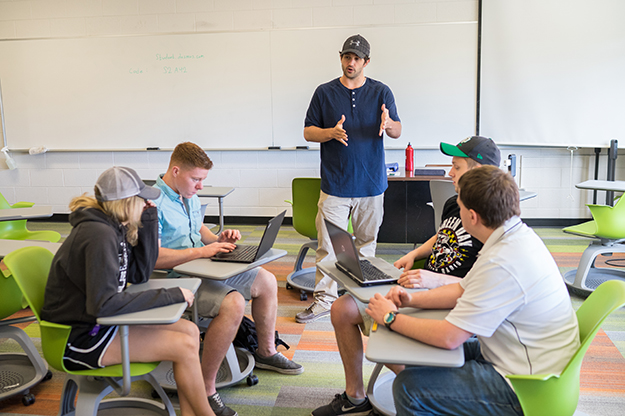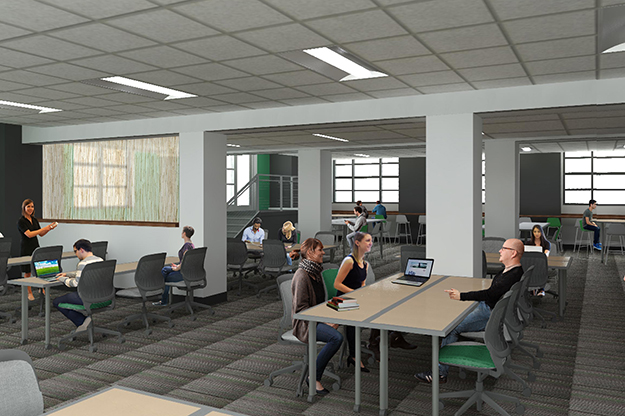New math
UND uses summer classes to test novel way of teaching through Math Active Learning Lab

Ten minutes into a summer pre-calculus class in UND’s Witmer Hall, Graduate Teaching Assistant Jarod Olson hasn’t written anything on the whiteboard.
He hasn’t asked his small group of students to turn in homework, or even to open their textbooks.
When one of his students describes to the group how he came to a conclusion on a problem, Olson replies, “Sounds like a solid argument to me.”
He’s not lecturing. He’s guiding.
Olson, a mathematics grad student from Lakeville, Minn., is testing a new style of teaching and learning math that will be fully integrated when UND’s Math Active Learning Lab (MALL) opens in O’Kelly Hall this fall. The new student-centered curriculum and learning space were developed to meet a growing challenge for undergrads.
UND data shows only 52 percent of pre-calculus students successfully completed the course with an A, B or C grade from Fall 2012 to Spring 2015 – a trend that is mirrored in pre-college credit developmental math classes and credit-bearing College Algebra, Trigonometry and Transition to Calculus.
“In the math department, we’ve known for a long time that students were not succeeding at the rate that we wanted them to succeed in these classes. This is the first opportunity we’ve had to make a significant change in the way we teach them,” said MALL Director Michele Iiams. “The research we’ve looked at for the learning model we’re implementing has shown that student success can increase, on average, 17 percent.”
That’s why College of Arts & Sciences Dean Debbie Storrs threw her support behind the development and funding of MALL.
“We had very high DFW (D, F or withdrawal) rates in courses in which, if students don’t do well, they can’t move to higher level math, which then prevents them from going into certain majors,” Storrs said. “We needed to learn how to teach math differently to help students be successful, given that they come in with a range of skills.”

Learning to learn
Olson is very forward with how he feels about the new curriculum that he helped develop with Iiams and her team, MALL Data Manager Tim Prescott and MALL Tutor Supervisor Gwennie Byron.
When he was an undergrad, he learned math as most do – listening to a professor for three to four hours a week. Then it was a solo struggle to complete the homework.
“I’m very jealous,” he said. “I think this is a great system, and I think students will really like it.”
With the MALL, students attend one “focus group” a week, where they work collaboratively to solve real-world math problems. Instructors are nearby to help direct thinking and discussion – but there’s no lecturing involved.
“You’re getting something out of coming to class, instead of tuning out and missing important pieces that will be on the test. You’re forced to be interactive,” Olson explained. “I want them to take a standpoint and argue with their peers. Also, we want them to ask for help from their peers so they can learn by teaching each other.”
Before attending the focus groups, students log in to a web-based learning system called ALEKS to watch videos and read learning pages that walk them through how to absorb the content. The system allows them to work on their own time and offers real-world practice problems.
“If there’s something I’m struggling with, I can do more practice on that specific thing, rather than just getting a sheet with a couple of questions,” said Nick Skinner, a junior computer science major enrolled in Olson’s Precalculus class. “It seems a lot easier to me.”
Outside of the focus groups, students will be required to spend time completing their ALEKS work in the MALL space, where tutors will be on hand to answer questions. Morning, evening and weekend hours mean this work can be done when it makes sense for the individual.
If a student is more skilled in math or progresses through the learning modules faster, they don’t have to wait for others. Enrollees can speed up or slow down the pace based on their needs, which keeps them from giving up or tuning out.
“I think the most exciting thing is that it’s individualized,” Storrs said. “Rather than assume all students are starting from the same place, the MALL allows us to support student learning based on their specific knowledge base and abilities. That’s pretty unique.”
Storrs anticipates the first wave of students will be apprehensive about this new way of learning – it happened when biology and chemistry unveiled their SCALE-UP flipped classrooms. Olson said he noticed this initially, but as the students learned how to learn, that changed.
“There was a really big increase [in support] after the first exam when everybody did really well,” he said. “I think as they start going on to exam two, and especially the final, they’ll realize how much material they remember.”
Worthy investment
The MALL way of learning took time and money – including a complete renovation to the O’Kelly basement. Storrs said the return is worth it; students are going to learn math and graduate promptly, supporting Goal Two of UND’s Strategic Plan.
“It should significantly help with retention, and it should significantly help people get through their math sequence and graduate on time. That’s one of the major reasons that not just the math department and the College, but the University invested in the MALL,” she said.
And as Olson points out, the returns go beyond retention and graduation.
“If we can get students to understand the math and remember the math better, and know how to apply the math to specific fields, then their fields will benefit from that knowledge,” he suggested.


